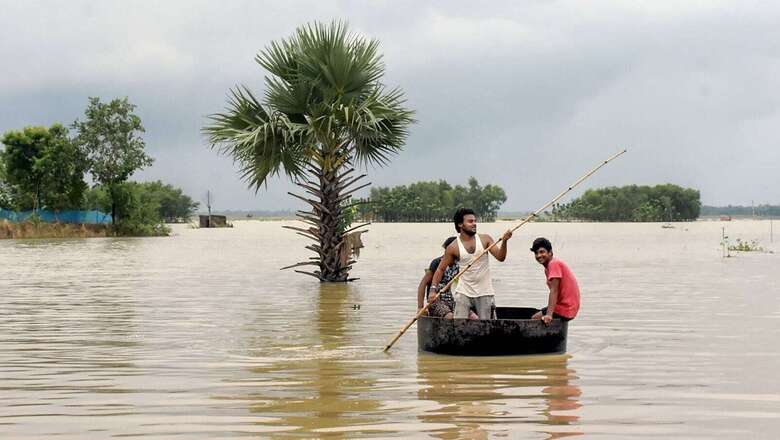
views
For a week now, the Central Water Commission (CWC) has been issuing “inflow forecast” for almost 40-odd storage dams and reservoirs across the country and suggesting the project authorities to “regulate the reservoirs as per the standard operating manuals/rule curve to avoid downstream flooding and upstream submergence”.
However, there are examples galore where the dam operators have not been exactly following the procedure. The latest being the flash floods witnessed in Assam’s Bongaigaon and Chirang districts after dam water was released by Bhutan on August 13 night from Kurichu dam on Aie river.
Last week, the water level crossed danger mark in the Ganga in UP’s Prayagraj district after the Kanpur barrage released 2.5 lakh cusecs water and the Matatila dam in Hamirpur too released 3 lakh cusecs water.
Earlier this month, West Bengal Chief Minister Mamata Banerjee had written to the Prime Minister Narendra Modi that the fresh spate of floods in her state was “man-made” and blamed the release of nearly 2 lakh cusecs of water from the three Damodar Valley Corporation (DVC) dams, which was nearly four times the amount of 58,000 cuses that the DVC was supposed to release.
In July last week, during the devastating floods at Chiplun in Konkan region in Maharashtra, there were complaints that the situation was exacerbated due to release of water from upstream dams in Raigad district.
Even on Monday, the CWC released “inflow forecast” for 42 reservoirs across nine states — 23 for reservoirs with gross storage capacity more than 80 per cent and 19 with gross storage greater than 60 per cent. It also sought a close watch for those reservoirs where “very heavy rainfall” or “extremely heavy rainfall” warning is issued for next five days. Fortunately, the Monday’s advisory did not have any such warning.
The India Meteorological Department (IMD) also issues a flash flood warning in view of the satellite images confirming soil saturation and heavy rainfall.
The question, therefore, is do the CWC advisories to the dam operators, especially in view of the excessive rains forecast, work? Has the damage caused any less over the years? What has been the track record?
South Asia Network for Dams, Rivers and People (SANDRP) has been tracking dams and reservoir managements for years now and claimed that as such there has been no change in the dam operations.
“Even this year, there were several dams that got filled up halfway through monsoon. But they have not followed the rule curve (and) they did not release water in time,” said SANDRP’s Himanshu Thakkar.
‘Rule Curve’ can be described as a standard operating procedure for dams defined taking into consideration dam capacity, reservoir water level, precipitation, floods etc. to ensure that there is no damage to the structural safety of the dam and less flooding in the downstream areas.
An advisory issued 24 hours before (or sometimes 72 hours before) basically is to help the local/civic administration and also the disaster management agencies to plan evacuation if needed, as mitigating measures. The CWC claims that it only does forecasting and it is the state governments who ultimately decide the threat perception and take actions.
Thakkar said that he had been suggesting to the CWC to issue rule curve with each of the advisories so that “the information is in public domain for all to see if a particular dam is following the rule curve or not.”
There is a ‘SOP for Flood Forecasting’ by the CWC and the dam operators have their Reservoir Operation Schedules (ROSs) – names vary sometimes in some states – every year. The CWC, however, does not issue individual letters or advisories. It is the common bulletin for pan-India situation.
CWC Chairman S.K. Haldar said the common bulletin is in public domain, goes on mail to the states’ Chief Secretary, head of the department concerned and also to the dam owner/operator.
“But after all, we can only issue an advisory. It is up to the dam owner to follow it or not. It is for him to take the risk for the property that was built spending thousands of crores of rupees.”
But it is not just what the CWC does with the advisory. Its own track record of maintaining data is questionable too. “The flood hydrograph for any given reservoirs are there only for 24 hours till the next graph comes. Forget for years, they don’t have past hydrographs of previous weeks either. This can and does hinder any audit or research vis-a-vis CWC flood forecasting,” Thakkar said.
Read all the Latest News, Breaking News and Assembly Elections Live Updates here.



















Comments
0 comment